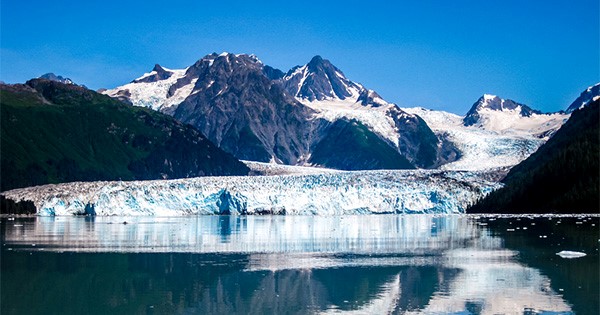
Editor’s Note: As part of the centennial celebration of the National Park Service (NPS), Cruise News will profile the superintendents of some of Alaska’s most popular parks.
Eric Veach, superintendent, Kenai Fjord National Park
Tell me a little bit about yourself.
I’ve recently started as the superintendent of Kenai Fjords National Park. I previously worked for over 16 years in Wrangell-St. Elias National Park and Preserve in Copper Center. I’ve also worked on a number of national forests, including the Tongass National Forest.
I enjoy fishing and hunting, along with farming. I grew up on a small farm in western Oregon and for now I’m keeping my 360-acre farm near Copper Center. I’m the proud father of two teenagers.
I consider myself an Alaskan and I like working on Alaska issues. I’m happy living in Alaska, facing the challenges Alaska poses while enjoying everything our great state has to offer.
What interested you in working at a national park and how did you get started?
My training is as a fisheries biologist. Both nationally and globally there are many examples of fish populations that have been overexploited or that have had their habitat altered greatly. Unfortunately, our track record of restoring fish populations hasn’t been very successful. After years of working with depleted fish stocks in the Upper Columbia River Basin with multiple agencies, I wanted the opportunity to work in a region where we still had the opportunity to protect intact fish populations. In the Spring of 2000, I had the opportunity to come to the Alaska Region and work on fisheries issues for the National Park Service at Wrangell-St. Elias and that started my career with the NPS. Since then my career with the NPS has grown, I’ve had the opportunity to engage in the management of many tremendous natural and cultural resources in some spectacular places, including Wrangell-St. Elias, Katmai National Park and Denali National Park. Serving as the Superintendent of Kenai Fjords will provide more opportunities for me in yet another truly magnificent park.
How has the 2016 tourist season been for the park?
Kenai Fjords was excited to celebrate the National Park Service Centennial with our visitors this year. We had a great visitor season with our numbers for May-August up 14 percent over the same time last year.
Is there a memorable story that has happened at the park this season?
I think the most memorable story this season has been the dramatic changes in Exit Glacier.
On August 15, rangers at Exit Glacier reported sudden changes in stream outflow from the toe of Exit Glacier. Initial reports indicated new flow on the south side of the lowest extent of the glacier toe. The new outflow from the toe of the glacier fluctuated from the south to the north side, carving out its route until it eventually flowed from beneath the entire width of the end of the glacier. The result was a dramatic and dynamic display of hourly channel changes and ice collapse along the toe of the glacier and discharge of numerous chunks of ice downstream into the outwash plain. From September 1-13, Exit Glacier retreated 30 meters (98 feet), as measured with a hand-held laser rangefinder. The total annual retreat is certainly more than this, and will be measured using both aerial photography from early September, and use of a mapping-grade GPS unit later this month.
What’s the biggest challenge facing the park?
I’d have to say it’s management of visitors to Exit Glacier. Exit Glacier is an outstanding natural feature and the changes that have occurred there provide a great opportunity to educate visitors about the effects of climate change. Many publications and other sources of information have created an expectation for our visitors that they will be able to hike to the edge of Exit Glacier and less than a decade ago this was possible. In fact, the name of one of our trails is the “Edge of Glacier” trail. Unfortunately, the glacier has retreated so rapidly that this is no longer possible. In addition, the terrain exposed by the retreating glacier is no longer conducive to trail construction so we don’t have the ability to continue to extend the trail towards the glacier. Many visitors leave the relative safety of the constructed trail without adequate hiking gear and attempt to reach the glacier in spite of numerous warning signs describing the risks of off-trail travel in this area. In addition, our visitation to Exit Glacier is starting to exceed the capacity of our infrastructure at the site. In 2018, we’ll undertake a new management plan for this area to address some of these challenges.
What has been the biggest event surrounding the 100 year birthday of the NPS?
For Kenai Fjords National Park I would say the unveiling ceremony for the “where mountains, ice and oceans meet” mural on the NPS Kenai Fjords Park Headquarters building in downtown Seward. We believe this mural represents the strong ties among the Seward community, visitors to Kenai Fjords National Park and the inspiring natural environment that surrounds us. The mural was created through a partnership between the National Park Service and the Seward Mural Society with generous donations from Alaska Geographic and other local donors. The mural was designed by the Seward Mural Society and Alaska master artist Byron Birdsall. The mural depicts kayakers exploring the ice in from of Aialik Glacier, a massive tidewater glacier that calves into Aialik Bay. The mural highlights the diversity of an interconnected icefield, glacier and coastal fjord ecosystem that attracts over 300,000 visitors each year.
What projects do you have coming up?
Our largest project in the foreseeable future is the renovation of our existing Visitor Center in Seward. This project will completely remodel the facility. The current building was constructed in 1986, not long after the park was first established. This building accommodates as many as 340,000 visitors per year and office space for up to 20 employees.It is a two-story building. The renovations will convert the entire first floor into a space that can accommodate a comprehensive educational interpretive media system. This will involve replacing deteriorated orientation exhibits from the late 1980s and designing new exhibits with improved accessibility.



